Install the app
How to install the app on iOS
Follow along with the video below to see how to install our site as a web app on your home screen.
Note: This feature may not be available in some browsers.
You are using an out of date browser. It may not display this or other websites correctly.
You should upgrade or use an alternative browser.
You should upgrade or use an alternative browser.
Official PS3 Thread
- Thread starter Sonic
- Start date
- Status
- Not open for further replies.
qwerty2000
Newcomer
i see that they'll be talking about the ps3 around the gdc of 2004 or the tgs like you said but in 2004 we will he about the ps3
Sonic:
I remember that. Wasn't it something like Suneet Shah's uncle who worked as an engineer on the PS2 design team, close to Kutaragi? I remember when, several days before the infamous microprocessor conference where Sony unveiled the EE, that kid posted what his uncle had said regarding the tens of millions more polygons the PS2 was going to push over DC, citing that 66 million tris/sec figure. Sorry to say we were among the first in the world choked by the smoke screen of Sony hype, polluting in a preludial manner the Dreamcast Technical Pages Forums with specious claims and fallacious comparisons.Few corrections. Some people knew about EE before it was announced at the trade show, specifically people from DCTP at the time.
Lazy8s said:Sonic:
I remember that. Wasn't it something like Suneet Shah's uncle who worked as an engineer on the PS2 design team, close to Kutaragi? I remember when, several days before the infamous microprocessor conference where Sony unveiled the EE, that kid posted what his uncle had said regarding the tens of millions more polygons the PS2 was going to push over DC, citing that 66 million tris/sec figure. Sorry to say we were among the first in the world choked by the smoke screen of Sony hype, polluting in a preludial manner the Dreamcast Technical Pages Forums with specious claims and fallacious comparisons.Few corrections. Some people knew about EE before it was announced at the trade show, specifically people from DCTP at the time.
again down this road....
and again, the EE can push more than 66 million polygons per second. that is RAW flat shaded polygons. that is what Sony said and that is the truth i'm afraid.... call it hype or not, that doesnt change the fact that in RAW performance, those are the numbers, whether u like it or not.
and i'm sorry to say that PS2 DOES push tens of millions of poygons more than most DC games....
but do we have to get into this discussion AGAIN?
london-boy:
It's not the number I have a problem with... it's how it was referenced by someone close to the PS2 design team when comparing to DC in-game statistics. That's what hype is - misleading.and again, the EE can push more than 66 million polygons per second. that is RAW flat shaded polygons. that is what Sony said and that is the truth i'm afraid.... call it hype or not, that doesnt change the fact that in RAW performance, those are the numbers, whether u like it or not.
You've fallen for it too? Reminds me of Sony and Microsoft's comparison "spec sheets" listing their system poly potential as 66 and 100+ million respectively against a paltry 6 for Nintendo, without so much as an asterisk to acknowledge the slant in the comparison. Or maybe you could list for me the PS2 games pushing 20, 30, 40, 50, and 60+ million tris under comparably complex conditions?and i'm sorry to say that PS2 DOES push tens of millions of poygons more than most DC games....
Grall said:Lazy:
I see you still have a sore tooth in your side regarding Playstation 2 being MORE POWERFUL than the silly little dc.
Grow up, get over it, and For FUCK'S sake stop whining. Thank you.
*G*
dont push it, or a new shenmue 9000 word essay will send u to the next millennium...
london-boy said:Grall said:Lazy:
I see you still have a sore tooth in your side regarding Playstation 2 being MORE POWERFUL than the silly little dc.
Grow up, get over it, and For FUCK'S sake stop whining. Thank you.
*G*
dont push it, or a new shenmue 9000 word essay will send u to the next millennium...
Sony is really putting alot of cash towards Cell related chips..
http://www.eetimes.com/semi/news/OEG20030529S0021
ARLINGTON, Va. — Sony Corp. plans to spend $4.27 billion (¥500 billion) in the next three years on semiconductor capital investments and another $4.27 billion in semiconductor R&D during the same period, the company said Wednesday (May 28).
The Japanese electronics giant said its chip capex for the fiscal year that started April 1 would be $1.5 billion (Â¥175 billion yen), while estimated R&D spending would be $1.25 billion.
Sony said a major area of focus would be next-generation processors based on the CELL technology joint-development it has with IBM Corp. and Toshiba Corp. The new processors are targeted for future electronic game consoles, home servers and broadband-capable TV.
Sony said it would also increase its investment in the area of next-generation organic electroluminescent and field effect displays.
The semiconductor capex and R&D goals are part of a corporate strategy to enhance Sony's global competitiveness. Sony said a major goal is to increase its current 4 percent operating profit margin to 10 percent by fiscal 2006.
http://www.eetimes.com/semi/news/OEG20030529S0021
marconelly!
Veteran
The best I can think of is that F1 game from Melbourne House that pushes something like 18M, by their own words. There are several games that I know that push 10-15M. Info of that kind is really difficult to come by, though. It's never released for most games.Or maybe you could list for me the PS2 games pushing 20, 30, 40, 50, and 60+ million tris under comparably complex conditions
More news from the PS3 front:
http://www.designchain.com/coverstory.asp?issue=spring03
I this just another example of Kutaragi GS (or was it EE) will not be in PS2??
http://www.designchain.com/coverstory.asp?issue=spring03
These problems may be a few years out, though. IBM has not announced when it will release the final chip, but the Cell project was originally envisioned as taking five years, suggesting that the final product may not be ready until as late as 2007. Although Sony refuses to talk about its future plans for the chip, it does admit that the Cell chip will not be the CPU in the Playstation3, reportedly slated for release in 2005.
I this just another example of Kutaragi GS (or was it EE) will not be in PS2??
megateto said:More news from the PS3 front:
http://www.designchain.com/coverstory.asp?issue=spring03
These problems may be a few years out, though. IBM has not announced when it will release the final chip, but the Cell project was originally envisioned as taking five years, suggesting that the final product may not be ready until as late as 2007. Although Sony refuses to talk about its future plans for the chip, it does admit that the Cell chip will not be the CPU in the Playstation3, reportedly slated for release in 2005.
I this just another example of Kutaragi GS (or was it EE) will not be in PS2??
the first stage is always DENIAL
second stage will be Acceptance
and the third stage will be fact
They WILL come out of their closet ! mark my words hehe
qwerty2000
Newcomer
that article turned out to be bull crap you didnt know that sony confrimed that there will be a cell for the ps3
This is also the guesstimate of PS3 from Impress Watch
Impress Watch Article
The title being "The Heart of PS3 "Cell" ~ 1TFlops"
Their guesstimated diagrams
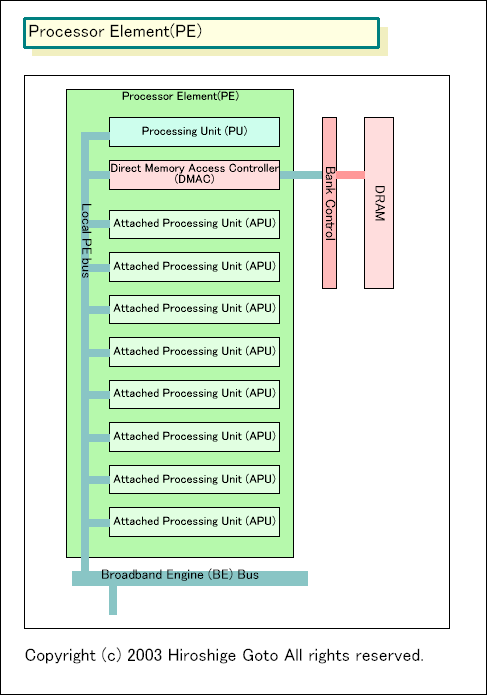
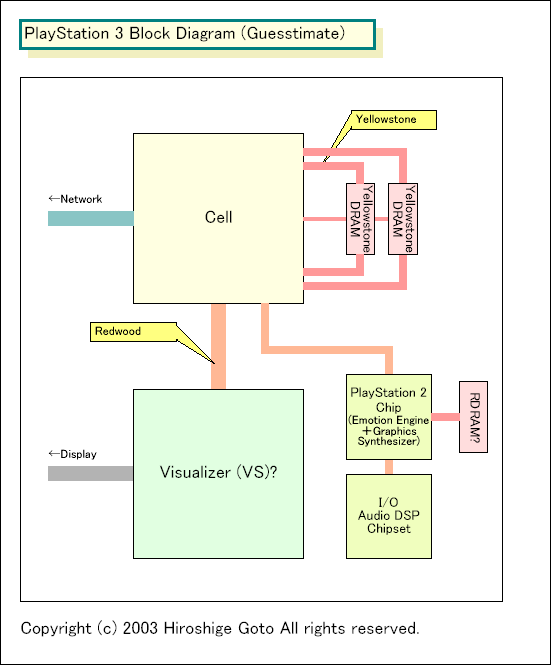
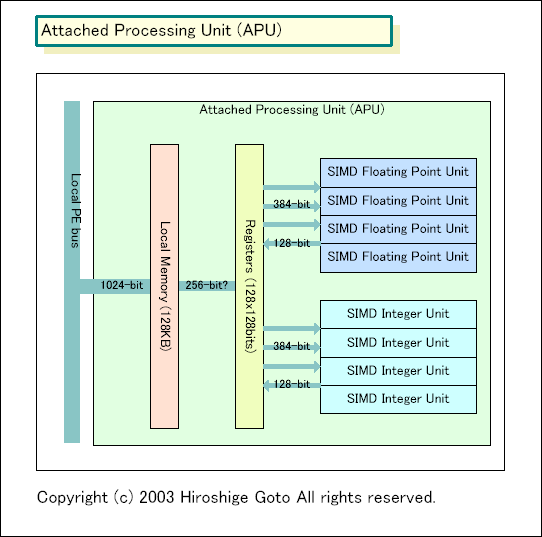
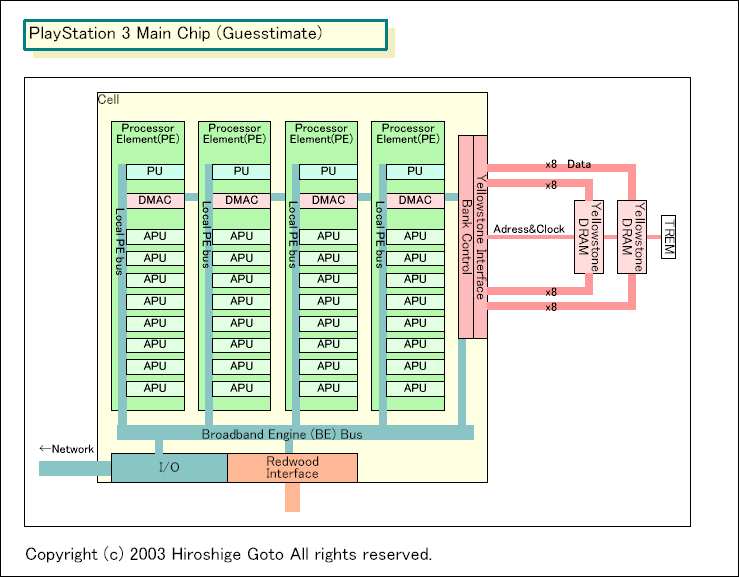
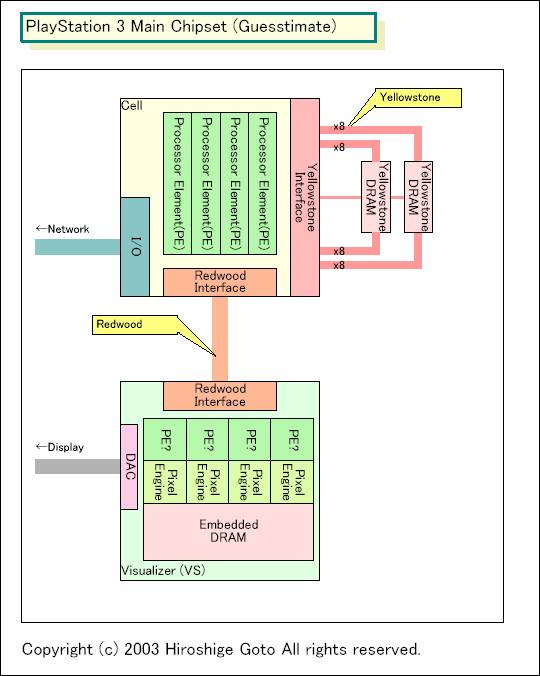
Impress Watch Article
The title being "The Heart of PS3 "Cell" ~ 1TFlops"
Their guesstimated diagrams





qwerty2000
Newcomer
i am very impress of your work good job do you have anymore diagrams to show us. The ps3 will have more than 1tflops from what i see.
qwerty2000
Newcomer
hey if anyone no this could anser this question. I was look at a pic of the patient showing the cell and the gpu of the ps3. Counting the apu's on the grpu is shows four which mean it could do 512 gflops. But some people say 256 gflops. which is right 256 or 512
Paul said:I wouldn't count on 512.. More like 256-384.
The article mentioned 512 parallel operations, also from the patent document.
Paragraphs below are translated by Excite Japan to "Engrish"
If Cell of PlayStation 3 assumes that it is the same composition as the suitable example of a patent document, what does a processing performance become? First, I will look at the degree of parallel of operation.
every -- Cell consists of four PE(s) -- having -- every -- PE -- eight APU(s) -- having -- every -- APU has four floating decimal point units and four integer units, and each operation unit usually presupposes that four data can be carried out for SIMD operation It is as follows when it does so.
PE number in Cell Four pieces
The APU number in Cell 32 pieces
The number of floating decimal point units in Cell 128 pieces
The number of integer units in Cell 128 pieces
The degree of 32-bit floating point arithmetic parallel of Cell 512 pieces
The degree of 32-bit integer operation operation parallel of Cell 512 pieces
It becomes 4 data x4 operation unit x8APUx4PE=512 piece operation. Therefore, it is said that Cell has the capability to be per one clock and the maximum and to perform simultaneously 512 32-bit floating point arithmetics and 512 32-bit integer operations.
Which hit does the frequency of Cell of operation target? According to the patent document, the floating decimal point unit of Cell is made desirable [ the performance of 32GFLOPS ]. Although this can read also like the performance of one floating decimal point unit if it is a Japanese patent document, since it is the plural form if it is an American document, this is clearly understood that they are 32GFLOPS(s) in the sum total of four units. If it does so, when it will count backward, as for the frequency of Cell of operation, it turns out that 2GHz is expected.
What does a performance become in 2GHz operation by the parallel processing of 512 data? By 512x2GHz, as for a floating point arithmetic, a peak serves as 1TeraFLOPS. The same is said of the integer operation. Incidentally, by the announcement data of former SCEI, it was supposed that it will attain "one Cell is a TeraFLOPS class operation performance." That is, it is in agreement with the performance of Cell in the composition of a patent document, and PITARI. It is surmised that Cell of PlayStation 3 resembles the desirable example of composition of a patent document also from this.
- Status
- Not open for further replies.
Similar threads
- Replies
- 23
- Views
- 2K
- Replies
- 13
- Views
- 2K
- Replies
- 28
- Views
- 3K
- Replies
- 183
- Views
- 19K
- Locked
- Replies
- 3K
- Views
- 342K

